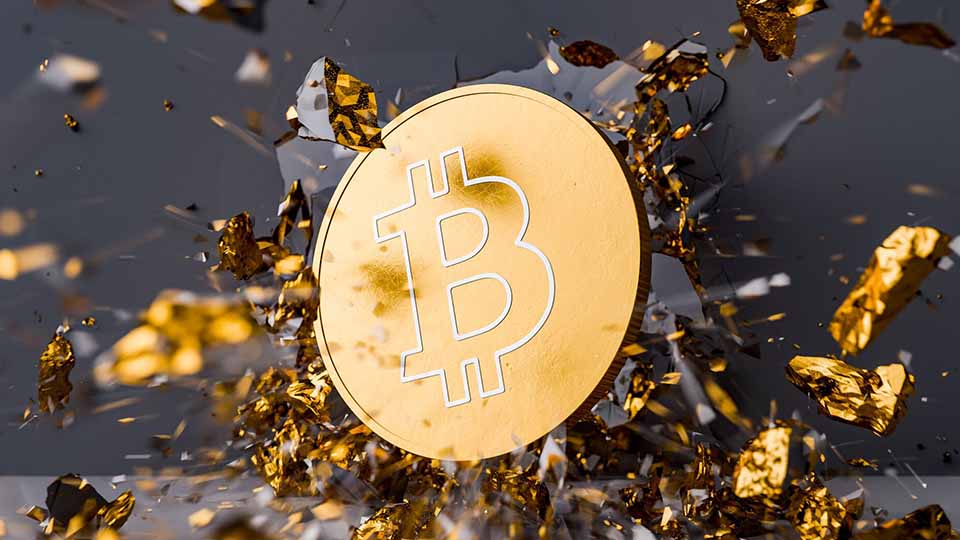2021 Highlights and 5 Crypto Predictions for 2022
10 December 2021
2021 was a huge year for crypto adoption and breakthroughs, and we expect this momentum to continue through 2022. Here we take a look at five of the biggest stories in the crypto sphere for 2021 and share our top predictions for what we anticipate may be the biggest stories in 2022.
2021 Crypto Highlights: Disruption and the Rise of Crypto Enablers
-
1. Fintech and traditional payments embrace blockchain and co-opt crypto solutions.
It’s widely accepted that the financial services industry is a primary disruption target of blockchain upstarts. We believe blockchain technology is inherently deflationary because it introduces higher degrees of efficiency and transparency, which immediately lower transaction costs. In 2018, Square established itself as an early crypto adopter by allowing users to buy and sell Bitcoin on the app. In 2021, PayPal, Venmo, Mastercard and even Twitter began allowing customers to transact in Bitcoin. As Mexican crypto-remittance firm Bitso illustrates, offering money transfer solutions at a cheap price can lead to immediate market share gains over incumbent financial firms like Western Union.
-
2. Blockchain transaction usage and smart contract adoption explode, reaching $3.5T in volume on ETH.
The Ethereum network is used for a wide variety of applications, from NFT ownership to smart-contracts. 2021 saw massive growth in Ethereum network transactions on the back of widespread proliferation and adoption of Ethereum-based projects (like NFTs). Going forward, we anticipate that smart contract networks like Ethereum and Solana will continue to grow in transaction size and notional value, as the network of participants and use cases continue to grow.
Explosive Growth in 2021: Total Value of Transactions on Ethereum Network
Source: Messari, VanEck. Data as of 9/30/2021.
-
3. Bitcoin begins to realize its full potential as a fiat currency disruptor, especially for emerging markets countries.
Since Bitcoin was launched in 2009, many Bitcoin maximalists have leaned on the idea that Bitcoin is a type of safe haven that may protect investors from the negative effects of monetary and fiscal policies implemented in both developed and emerging markets. Because Bitcoin is decentralized and has a fixed supply, it will not face the inflationary pressures that affect fiat currencies around the globe. From a geopolitical perspective, Bitcoin may provide emerging markets countries a monetary alternative to relying upon unfavorable IMF/World Bank loans, which sometimes exacerbate, not help, the problem.
In September of 2021, El Salvador officially recognized Bitcoin as legal tender, the first country to do so. Read more about the impact of this in Matthew Sigel’s Dispatch from Bitcoin Beach.
-
4. China’s mining crackdown shifts global mining market share to favor U.S. miners.
China has had a “love/hate” relationship with Bitcoin since the digital currency’s launch in 2009. On one hand, China’s miners controlled a significant portion of global hash-rate, in addition to being one of the main producers of Bitcoin-focused ASIC chips. On the other hand, the Chinese government threatened to ban Bitcoin mining and trading and introduced escalating restrictions on crypto, which culminated in an outright ban on crypto trading, mining and exchanges. While the long-term effects remain to be seen, the short-term effects are obvious. Crypto miners fled the country, and the global mining market share shifted immediately to favor U.S.-based miners. With China exchanges and mining out of the picture, U.S. and other miners face less competition and have more opportunity to grow their portion of the global hash-rate.
-
5. Crypto IPOs highlight the massive growth of digital asset businesses, while the market cap of crypto-enablers encroaches on more established industries.
2021 was a huge year for companies going public in the crypto space. Coinbase made history as the biggest digital asset listing in history, coming to market at twice the valuation of Nasdaq and nearly the size of Intercontinental Exchange (ICE), the parent company of the New York Stock Exchange. Beyond Coinbase, a number of miners and other crypto enablers went public, including Coinshares, Bakkt and Stronghold Digital Mining.
As a group, the market valuations of crypto enablers as represented by the MVIS Global Digital Assets Equity Index grew significantly in 2021 on the back of a wave of IPOs and price performance. Crypto enablers are now approaching the market valuation of their spiritual competitors – gold miners!
Crypto Enablers Approach Gold Miners Market Cap
Source: Factset, VanEck. Data as of 10/31/2021. Please see index definitions below.
2022 Crypto Predictions: More IPOs, More Use Cases, More Adoption
-
1. In 2022, even more crypto-intensive businesses will go public.
We believe that there is a deep pipeline of crypto-enabling companies preparing to go public, and that 2022 will continue the trend set by newly listed companies in 2021. There are a wide range of businesses that crypto companies can participate in – from exchanges to digital asset miners to payment companies. As the crypto market continues to grow and develop, we anticipate the market to grow with new listings, and also shift as companies win and lose market share.
Digital Asset Companies at the Forefront of the Digital Transformation
-
2. NFT (non-fungible token) hits mainstream culture with millions of users, and the next major use cases to emerge will be sports ticketing, loyalty points and esports.
NFTs had a breakout year in 2021, but we believe the best is yet to come. In our view, two things are holding back NFTs from even wider adoption than what has already taken place. The first is that the user interface (UI) for NFT platforms needs to become more accessible for non-crypto natives to participate. NBA’s TopShot was a great example of an NFT project that made it easy for non-crypto natives to purchase an NFT. The second stepping stone to widespread adoption is use cases that go beyond merely holding an item in a digital wallet. While there have been some outside-the-box applications coming to market, we believe that sports ticketing, loyalty points and esports will emerge as the next big areas where NFTs will make a splash. The smart-contract optionality that the NFT platform provides will entice participation because more features, like premium seat lotteries, will drive higher engagement and adoption from fans.
-
3. ETH undergoes major software upgrade that moves it away from energy intensive mining and increases network capacity.
Bitcoin and Ethereum both utilize a “proof of work” (PoW) mechanism to verify information recorded on the blockchain and prevent certain types of attacks. In 2022, Ethereum plans to shift from “proof of work” to “proof of stake” (PoS), which will dramatically alter the landscape for Ethereum-focused miners. Instead of expending energy solving computationally intensive problems (PoW), proof of stake will provide better energy efficiency, an increase to network capacity, lower barriers to entry and stronger immunity to centralization for the Ethereum blockchain. One of the main drawbacks of the proposed upgrade is that Ethereum mining will no longer be profitable, meaning miners focused on Ethereum will need to move on to greener pastures.
-
4. BTC continues to mature in terms of broader institutional ownership and adoption, as another emerging markets country may declare BTC as legal tender (El Salvador 2.0).
As the broader digital asset market grows, we anticipate that more companies will adopt Bitcoin as a balance sheet asset and potential revenue generator from mining operations. As evidenced by El Salvador, certain emerging markets countries may also find Bitcoin useful as a monetary tool, and a potential option for avoiding some of the negative side-effects of relying solely on the IMF/World Bank for debt assistance.
-
5. ESG capital and investors find BTC as an accelerant of green energy adoption and financial inclusion.
Unfortunately, ESG concerns continue to plague the cryptocurrency industry, specifically concerns surrounding the energy usage required to mine Bitcoin. While the debate continues, we believe that crypto miners will continue to lead the way in terms of green energy adoption and financial inclusion. Riot Blockchain, a leading U.S. Bitcoin miner, is already a fierce advocate and proponent of the Bitcoin mining industry as a force for good in the conversation around sustainable energy usage. Stronghold Digital Mining, which listed in Q4 of 2021, is another ESG-focused Bitcoin mining company, which utilizes coal mining refuse (coal mining by-product) to generate the power used to mine Bitcoin. We anticipate that sustainability-focused mining companies will continue to grow their market share.
DAPP: Invest in Digital Transformation
The VanEck Crypto and Blockchain Innovators UCITS ETF (DAPP) seeks to track the MVIS Global Digital Assets Equity Index and provides exposure to the companies involved in the digital transformation of the global economy. DAPP’s underlying index only invests in digital transformation companies, and does not invest in actual digital assets like cryptocurrencies, or cryptocurrency investment vehicles. The index is designed to provide pure-play exposure to the companies that are actively participating in the digital transformation, which may benefit from the structural long-term growth of digital assets.
Index Disclosures
MVIS Global Digital Assets Equity Index: intends to track the largest and most liquid companies in the digital assets segment.
MVIS CryptoCompare Bitcoin Index: intends to track the price of Bitcoin.
MVIS CryptoCompare Ethereum Index: intends to track the price of Ethereum.
NASDAQ 100 Index: intends to track 100 of the largest non-financial companies listed on the Nasdaq stock market.
S&P 500 Index: intends to track the performance of 500 large companies listed on stock exchanges in the United States.
MSCI ACWI Index: seeks to track the investment results of an index composed of large and mid-capitalization developed and emerging market equities.
The LBMA Gold Price is administered independently by ICE Benchmark Administration (IBA). IBA independently administers the price and provides the auction platform on which the LBMA Gold Price is calculated, while LBMA own the intellectual property rights. The platform is electronic, tradeable, auditable and in line with the IOSCO Principles for Financial Benchmarks.
NYSE Arca Gold Miners Index (GDMNTR) is intended to track the overall performance of companies involved in the gold mining industry.
Important Disclosure
This is a marketing communication. Please refer to the prospectus of the UCITS and to the KID before making any final investment decisions.
This information originates from VanEck (Europe) GmbH, which has been appointed as distributor of VanEck products in Europe by the Management Company VanEck Asset Management B.V., incorporated under Dutch law and registered with the Dutch Authority for the Financial Markets (AFM). VanEck (Europe) GmbH with registered address at Kreuznacher Str. 30, 60486 Frankfurt, Germany, is a financial services provider regulated by the Federal Financial Supervisory Authority in Germany (BaFin).
The information is intended only to provide general and preliminary information to investors and shall not be construed as investment, legal or tax advice VanEck (Europe) GmbH, VanEck Switzerland AG, VanEck Securities UK Limited and their associated and affiliated companies (together “VanEck”) assume no liability with regards to any investment, divestment or retention decision taken by the investor on the basis of this information. The views and opinions expressed are those of the author(s) but not necessarily those of VanEck. Opinions are current as of the publication date and are subject to change with market conditions. Certain statements contained herein may constitute projections, forecasts and other forward-looking statements, which do not reflect actual results. Information provided by third party sources is believed to be reliable and have not been independently verified for accuracy or completeness and cannot be guaranteed. Brokerage or transaction fees may apply.
All performance information is based on historical data and does not predict future returns. Investing is subject to risk, including the possible loss of principal.
No part of this material may be reproduced in any form, or referred to in any other publication, without express written permission of VanEck.
© VanEck (Europe) GmbH / VanEck Asset Management B.V.
Sign-up for our ETF newsletter
Related Insights
Related Insights
16 January 2025
27 November 2024
27 November 2024
07 November 2024




